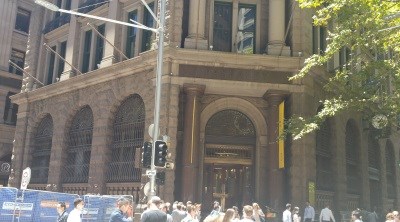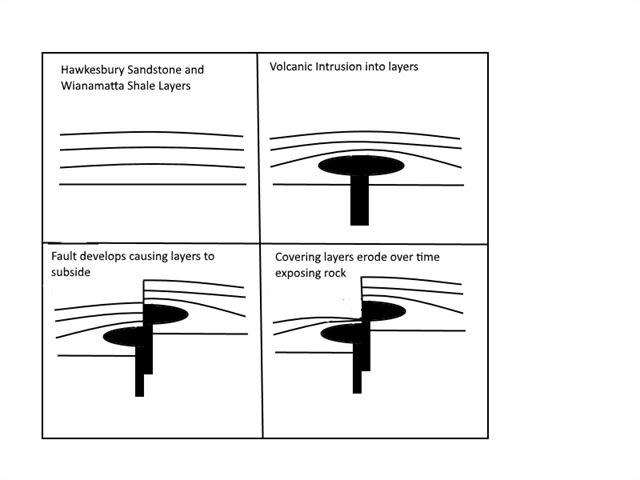Trachyte was originally used in 1880s to replace sandstone street kerbs. Sandstone was readily available in Sydney, but unfortunately, was not very durable. Trachyte hardness made it a durable and suitable replacement. In the early 1900s, architects soon realised the usefulness of the stone. It was originally marketed as "Bowral trachyte" and was quarried from the Mount Gibraltar quarry near Bowral in the Southern Highlands of New South Wales.

Image copyright: Own work.
The facade of the building at the co-ordinates contains a mixture of the rough hewn and also polished stone. At the top corner of the building, an intricate motif of the former Bank's crest was carved out of the stone.
Trachyte from Bowral dates from the Jurassic period of Earth's history. It is a plutonic rock called microsyenite. The Sydney Basin is comprised of a layer of Sandstone, called "Hawkesbury Sandstone" and a layer of shale named "Wianamatta Shale". These layers were formed in the Triassic Era (over 200 Million years ago).
During the Jurassic period (about 150 to 200 Million years ago), there were three periods of igneous activity, meaning that was volcanic activity near Bowral. Rock from that area dates it to being formed in the second of those three volcanic periods. The trachyte was derived from a high-level sill in the volcano. which is called a laccolith.

Image copyright: Public Domain.
The volcanic activity did not break the surface. Instead, it caused an intrusion into the layers of the basin. The molten rock subsequently cooled in the intrusion and formed into the present rock between the two layers. Over the next 180 million years, the sandstone eroded and exposed the now solid volcanic intrusion. The exposure of this intrusion at Bowral led to its discovery and eventual quarrying.

Image Copyright. Own work based on other works.
At the listed co-ordinates, you will find a stone buttress made of trachyte (if your GPS is playing up in the CBD due to the buildings, it is the first buttress east from the western corner buttress).
The polished rock helpfully highlights the variations in the structure of the rock, and shows up the imperfection on a closer examination. On this buttress you will find a pegmatite in the shape of a snake (head down, tail going up). Pegmatites are formed during the cooling process of the molten rock. Water and other substances permit the growth of coarse crystals in the rock structure during the cooling of the magma. The size of the crystals can range from millimetres to metres in size. Large crystal formations are dependent on slower cooling times for the magma.
To log the cache, please answer the following questions:
1. From your observations, what characteristics of the pegmatite allowed you to easily distinguish it from the trachyte.
2. Estimate the size of the crystals in the pegmatite (in millimetres, centimetres or metres).
3. Based on your estimation of their size, do you think that the pegmatite cooled quickly or slowly.
You may log the cache once you message the answers. If an answer needs clarification, I will message you back. If you haven't send the answers within a week, your log might be deleted.
You may optionally upload a picture of your visit, but please, no photos of the pegmatite.
Sources
http://www.nationalrockgarden.org.au/assets/Uploads/listingitems/Newsletter-No7October-2013.pdf
http://www.sandatlas.org/pegmatite/
http://www.southernhighlandnews.com.au/story/2397891/the-hard-rock-story-of-trachyte-sourced-from-the-gib/